【Ray Tracing The Next Week 超详解】 光线追踪2-6 Cornell box
Chapter 6:Rectangles and Lights
今天,我们来学习长方形区域光照
先看效果
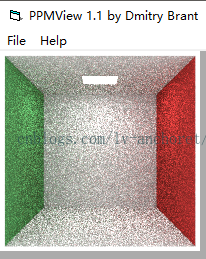
light
首先我们需要设计一个发光的材质
/// light.hpp // -----------------------------------------------------
// [author] lv
// [begin ] 2019.1
// [brief ] the areaLight-class for the ray-tracing project
// from the 《ray tracing the next week》
// ----------------------------------------------------- #pragma once namespace rt
{ //the statement of areaLight class class areaLight :public material
{
public:
areaLight() { } areaLight(texture* mat) :_emit(mat) { } virtual bool scatter(const ray& InRay, const hitInfo& info, rtvec& attenuation, ray& scattered)const { return false; } virtual rtvec emitted(rtvar u, rtvar v, const rtvec& p)const { return _emit->value(u, v, p); } private:
texture* _emit;
}; } // rt namespace
关于设计方面,我们需要把发光函数设为可继承虚函数,基类也要添加,但是不是所有的材质都需要发光,所以,基类中的发光函数并不需要设置为纯虚
/// material.hpp // -----------------------------------------------------
// [author] lv
// [begin ] 2018.12
// [brief ] the material-class for the ray-tracing project
// from the 《ray tracing in one week》
// ----------------------------------------------------- #pragma once namespace rt
{ // the statement of material class class material
{
public: /*
@brief: produce a scattered ray
@param: InRay -> Incident light
info -> the information of intersect-point(hit-point)
attenuation -> when scattered, how much the ray should be attenuated by tis reflectance R
scattered -> as we talk, it is a new sight; or
it is the scattered ray with the intersect-point
@retur: the function calculate a scattered ray or not
*/
virtual bool scatter(const ray& InRay, const hitInfo& info, rtvec& attenuation, ray& scattered)const = ; /*
@brief: 自发光
@param: 纹理所需信息
@retur: 纹理像素值
*/
virtual rtvec emitted(rtvar u, rtvar v, const rtvec& p)const { return rtvec(); } }; }
这样的话,一般的材质继承之后,发光为黑色即不发光,较为合理
我们既然添加了光照,那么计算插值函数时候也要将它加进去
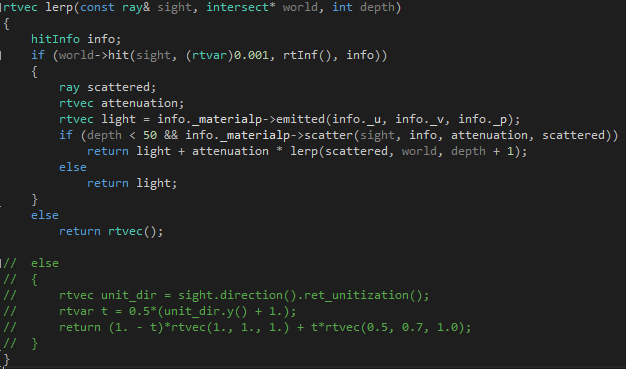
到此,我们的发光材质就设置妥当了
rectangle
我们定义的长方形均为平行于轴的
(引用书上一张图)
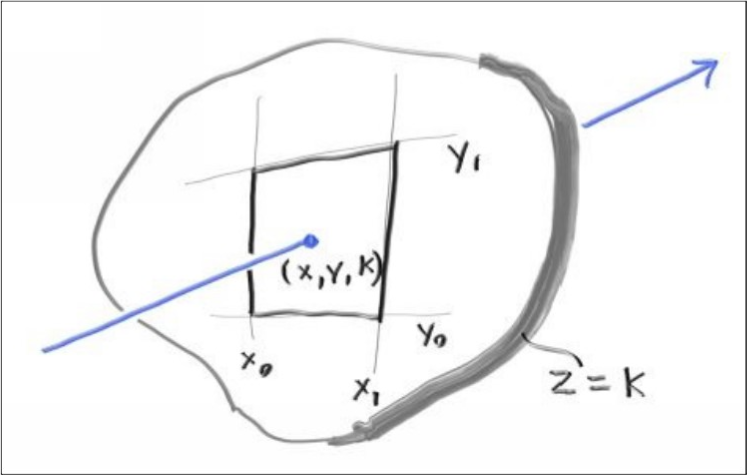
假设长方形位于 z = k 平面,x和y边界如上,交点为P(x,y,k)
我们如何确定光线参数t?
已知:
光线:p(t) = eye + t * direction
则,z方向的方程为:z(t) = eye.z + t * direction.z
那么,若满足z = k,则
t = (k - eye.z) / direction.z
同理可得x和y的等式
如果,得到的x坐标或者y坐标不在边界之内,那么就没有相交,反之则光线和长方形相交
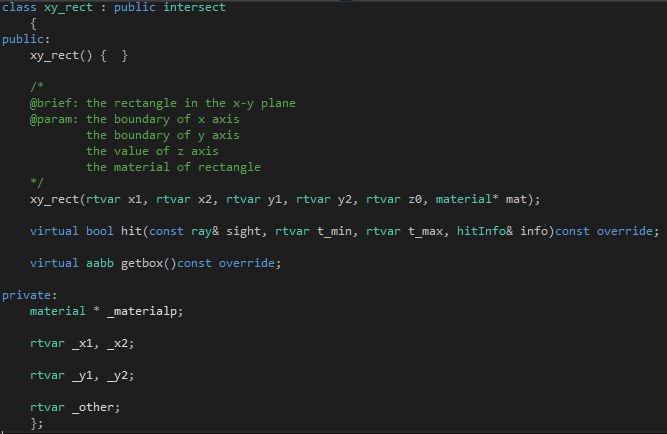

上面的代码都比较简单,那个 hit 呢,就是,根据已知的一个分量求出t,然后,把这个解带入求出对应的其他两个分量,如果其他两个分量不在边界内,那么返回false
反之,我们求取该点的纹理坐标,以及其他碰撞点信息记录之
获取包围盒嘛,理论上面无厚薄,线无粗细,但是实际中面有厚薄,我们可以将厚度设置为0.0002,以此模拟理论厚度
同理写出其他两个平面类即可。
这个没什么问题,我们就往下进行
我们来做Cornell box

相机参数设置:

得到的图如下:
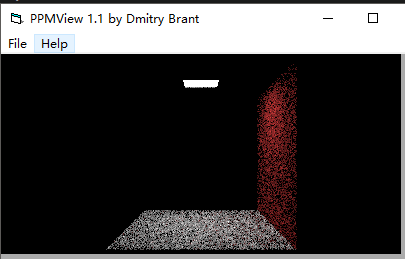
有几个面是黑色的??也就是根本没画出来
我们细细看一下,发现,长方形的法向量是关键
比如画出来的红墙,对面与之平行的面的法线是朝左边的,展现在我们视线中的是背面
所以,我们有时候需要反转一下法向量
/// flip_normal.hpp // -----------------------------------------------------
// [author] lv
// [begin ] 2019.1
// [brief ] the flip_normal-class for the ray-tracing project
// from the 《ray tracing the next week》
// ----------------------------------------------------- #pragma once namespace rt
{ class flip_normal: public intersect
{
public:
flip_normal(intersect * p) :_p(p) { } virtual bool hit(const ray& sight, rtvar t_min, rtvar t_max, hitInfo& info)const override
{
if (_p->hit(sight, t_min, t_max, info))
{
info._n = -info._n;
return true;
}
return false;
} virtual aabb getbox()const override
{
return _p->getbox();
} private:
intersect* _p;
}; } // rt namespace
这样就可以了,我们改一下场景
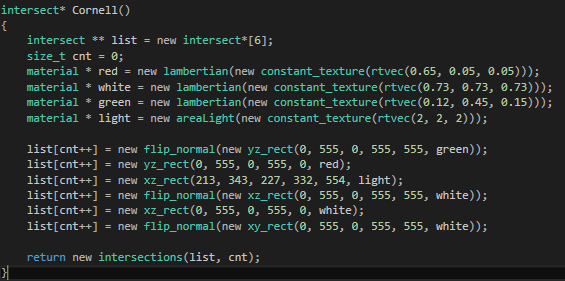
如下:
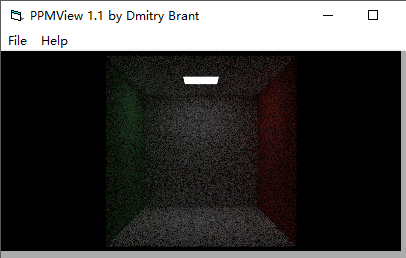
此外,我们还需要注意的是,light对应的纹理中的数值越大光强越强
我们可以试一下
material * light = new areaLight(new constant_texture(rtvec(, , )));
如下:
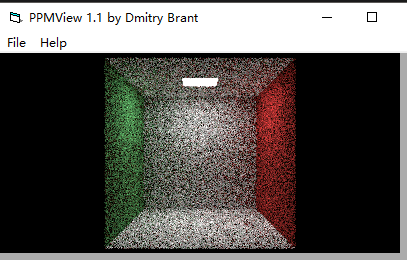
可以看出来两张图对比之下,第二张亮多了
但是我们依旧看着很不舒服,好多黑点点,太难受了
我想啊想,为什么这么多黑点??可能是因为背景是黑色的,毕竟是漫反射,如果随机反射失败那就是黑色,所以随机反射点可能产生好多黑色小点,你千万别想着换成镜面材质,那个更无语
所以啊,我想了下,把背景改为白色,那样更好,毕竟色彩中掺杂一点白色,无伤大雅
如是,我改了下,效果可观
此法只适用于Cornell box本身,具体场景下的画面优化请见下一篇
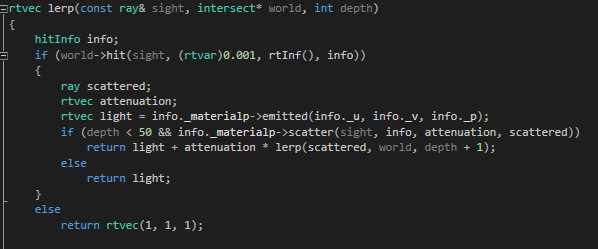

感谢您的阅读,生活愉快~
最新文章
- dataset 修改小数点位数
- oracle中merge方法
- 5.String
- poi批量导入excel文件
- mysql 常用查询
- mvc model 传值两种方式区别
- GridView 和ListView中自适应高度
- 51nod1089最长回文子串V2
- 【设计模式 - 2】之单例模式(Singleton)
- nodejs之简介及安装(一)
- 怎么在Ubuntu Scope中获取location地址信息
- SQL Server基础之表级触发器
- Gogs 部署安装(Linux)
- 【C语言】 重拾
- webpack4升级extract-text-webpack-plugin和UglifyJsPlugin问题
- es_5.4.4 reinstall log and upgrade to V6.5.4--APM
- POJ - 1474 :Video Surveillance (半平面交-求核)
- .NET本质论 方法
- Python 模块EasyGui详细介绍
- 2、let 和 const 命令